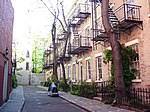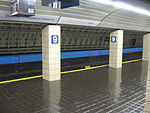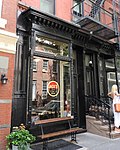Jefferson Market Prison

The original jailhouse at this site was built alongside a police court and volunteer firehouse in the 1833 Jefferson food market, named for the former president. The jail was torn down in 1873.In 1877, the prominent Jefferson Market Prison opened at 10 Greenwich Avenue, together with the adjacent Third Judicial District Courthouse. Frederick Clarke Withers designed these twin buildings in an ornate American Gothic style. The landmark courthouse survived Jefferson Market's 1927 demolition and today serves as a New York Public Library branch. A third building—the only Art Deco jail ever built—operated here from 1931 to 1971 as New York Women's House of Detention.The site is now a small park known as Jefferson Market Garden.
Excerpt from the Wikipedia article Jefferson Market Prison (License: CC BY-SA 3.0, Authors, Images).Jefferson Market Prison
Greenwich Avenue, New York Manhattan
Geographical coordinates (GPS) Address Nearby Places Show on map
Geographical coordinates (GPS)
| Latitude | Longitude |
|---|---|
| N 40.7345 ° | E -73.9996 ° |
Address
Greenwich Avenue 15
10014 New York, Manhattan
New York, United States
Open on Google Maps







